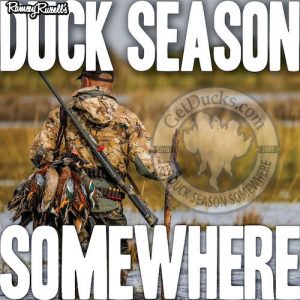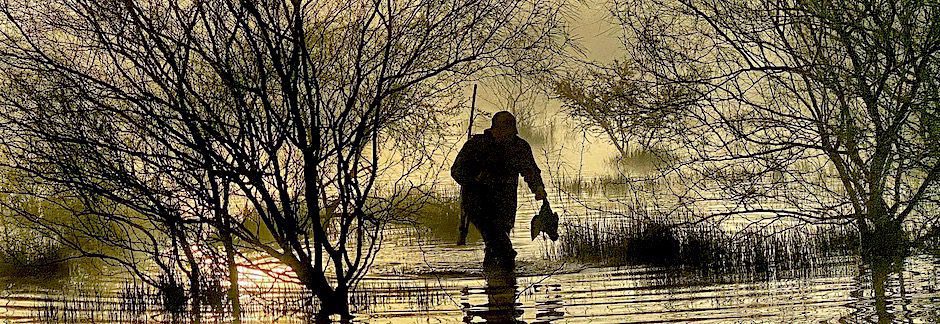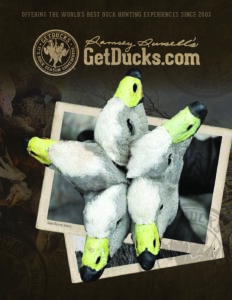MOJO’S Duck Season Somewhere Podcast
EP 461. Wisconsin Waterfowl

With 63,000 license holders, it’s fair to say that waterfowl hunting is a pretty big deal in Wisconsin! Wisconsin Waterfowl Association was founded decades ago to address waterfowl and habitat conservation at the local level. Executive Director Bruce Ross describes habitat projects that keep them busy, mission-critical partnerships, and the increased importance of Wisconsin waterfowl hunters in an ever-changing landscape.
Related Links:
Wisconsin Waterfowl Association wisducks.org
EP 460. Going for the Gold

Amber English grew up around hunting and guns in Colorado, learning to shoot when she was only 6 years old. While her parents, uncle and aunt all shot competitively, it wasn’t until after highschool gymnastics that she began doing so. Now a Captain in the US Army, she humbly describes choosing shotguns over rifles, shooting her way into international skeet shooting competitions, joining the Olypic Team, winning the gold (where she set a new Olympic record, by the way) and preparing to do it again. We also talk about traveling with firearms and, with the warning that I can miss with the absolute best of ’em, make plans to duck hunt together.
EP 459. 50 Ducks

Anything can happen while duck hunting. Greer Smith probably isn’t the only person the get stuck while hunting near Venice, Louisiana, but watching ducks fly overhead and wondering where they’d originated sent his life into a new orbit. “There’s a growing need for awareness,” says Greer, who grew up duck hunting in Georgia. Quitting his day job and putting plans into motion, he started 50 Ducks in hopes that he can spark an interest in waterfowl conservation among school children and the non-hunting community. This year he’s banding ducks in Sonora Mexico and at Jack Miner’s in Ontario. Greer eventually hopes to generate much needed revenues to fund waterfowl research projects. Along with a drake shoveler named Sir Dabble presently streaming his whereabouts from nature to computer monitors worldwide, he’s off to a danged good start! See related link below!
Related Links:
Use promo code “GetDucks” to recieve 10% discount on a 50 Ducks subscription!
EP 458. Outdoor Life Hunting Stories

While growing up on a farm in rural Missouri, his dad had predicted he’d become a newspaper reporter. Probably because he intuitively knows the value of a story. Sure enough, Andrew McKean’s colorful career eventually took him to Outdoor Life, where as the long-time hunting and conservation editor, he’s drilled into issues that affect wildlife, wildlands, and people. An incredible storyteller, McKean dives headlong into memorable hunting trips, like the time he recovered legendary Jim Corbet’s famous tiger hunting rifle from a British museum and retraced his steps through India, and the time he went on the very last caribou hunt to ever take place in Quebec. Borrowing from that last caribou hunt, he describes why some conservation groups consider the American Buffalo as practically extinct, and others’ plans to fix it. Outdoor Life was the last hunting magazine to have over a million subscribers. Everything is now digital, and making a career in the outdoor writing field these days is also discussed.
EP 457. BS’ing with Redbeard Between Roadtrips

Between chasing waterfowl and promoting Voormi, my buddy Ryan Yarnell aka Tex aka Redbeard sees as much of North America through a truck windshield as I do each year. Every now again our paths cross and we even get to hunt ducks together. In between roadtrips, Yarnell and I catch up, talking about Voormi’s new bibs and rain jacket, this past US duck season, driving the highways and byways, our hunting retrievers, snow geese, and duck hunting West Virginia. You know, pretty much the same nothing that all duck hunting buddies talk about.
EP 456. How Mallards Experience and Utilize the Landscape

We all know duck habitat when we see it, but what do ducks “see”–how do our beloved mallards experience and utilize habitats at the landscale level before, during and after hunting season? Could understanding this make us more productive hunters, better habitat managers and long-time conservationsists? Nick Masto (that’s Masto) is a duck hunter and recently completed his PhD at Tennessee Tech using the latest technologies. We do a deep dive into mallard habitat preferences on the wintering grounds and during fall/spring migrations, why they prefer these habitats, when they migrate, why they stop migrating, available forage on private versus public lands, hunting pressure influences, daily flight distances, the importance of early and late water on the landscape, sanctuary connectivity, landowner cooperatives and more. Whether a hunter, a waterfowl habitat manager, or both, you’ll likely appreciate seeing your hallowed stomping grounds through the eyes of wild mallards.
EP 455. Need-To-Know Backyard Conservation and Hunting Topics

How has hunting changed in the United States since yesteryear–and why? Whether private or public lands, is it as easy to gain access? And how does the increasingly non-hunting public view hunters and hunting? Award-winning writer, public speaker and recurring FOX News guest, Gabriella Hoffman and I race through a list of ongoing need-to-know topics from right here in our back yard: roadkill legislation, banning hunting dog events, how the famously publicized Hollywood Buck influences public perceptions, defunding hunter- and firearm-related wildlife management, using no-tox ammo and green energy to marginalize hunter access, net-zero agenda and much more. Is it a red versus blue state thing? Simply a sign of times, or by design? And what can you do about it? Listen, decide, and let us know your thoughts.
EP 454. Duckboats Renaissance

Back in the internet stone ages way before social media platforms, old-school do-it-yourself duck hunters from around the world gathered in online communities known as duck hunting chatrooms–sharing local traditions, exchanging ideas, swapping hunts. It was almost like discovering fire! Decades later, Duckboats.net still exists and is thriving like a most-popular Smalltown, USA coffeeshop. “The best duck boats stand out at the boat ramp but vanish in the marsh,” says duckboat.net founder Eric Patterson, when we started talking about constructing and using various type duck boats deployed throughout North America. More than just duck boats though, this old school community covers an everything-under-the-sun broad range of waterfowl- and life-related topics. Today’s conversation meanders through the most interesting things found while hunting (y’all ain’t goin to believe what he found in Alabama), public land hunter harrasment, duck hunting then versus now, chatrooms versus social media, and the good, bad, and downright ugly things wrought by the internet.
Related Links:
EP 453. Skelly Woods

“I’d known about it forever,” says John Williams, speaking about a large, diamond-in-the-rough bottomland hardwood tract along a river in Oklahoma, “And dreamed of owning something like it one day.” He cut his teeth duck hunting Oklahoma public lands and followed his father’s footsteps into realty, forging his way into recreational properties before it was really even a thing. That dream property finally came for sell. He’s since spent decades learning the property, developing it into the largest hardwood wetland in the state, fine-tuning management, and instilling in his sons the same love and appreciation for it that he himself feels. We cover lots of topics you’ll appreciate whether you’re a landowner or, like myself, still dreaming.
EP 452. The Feather Thief

Is it true that “man is seldom content to witness nature…he must posess it?” What is it about beautiful feathers that so obsesses some of us? Truth is truly stranger than fiction, and some stories you couldn’t contrive in a lifetime’s worth of imagination. Kirk Wallace Johnson’s The Feather Thief is prime example–a child prodigy flutist becomes a world-champion salmon fly tier, breaks into British Natural History Museum, stealing hundreds of rare bird skins worth millions of dollars in the fly-tying underworld but irreplacably priceless to the scientific community. Anything for those beautiful feathers! For fame? For money? Told masterfully, Johnson’s investigative story explores man’s obsessive instinct to harvest–and to collect–nature’s beauty. It’s a story as old as time.








